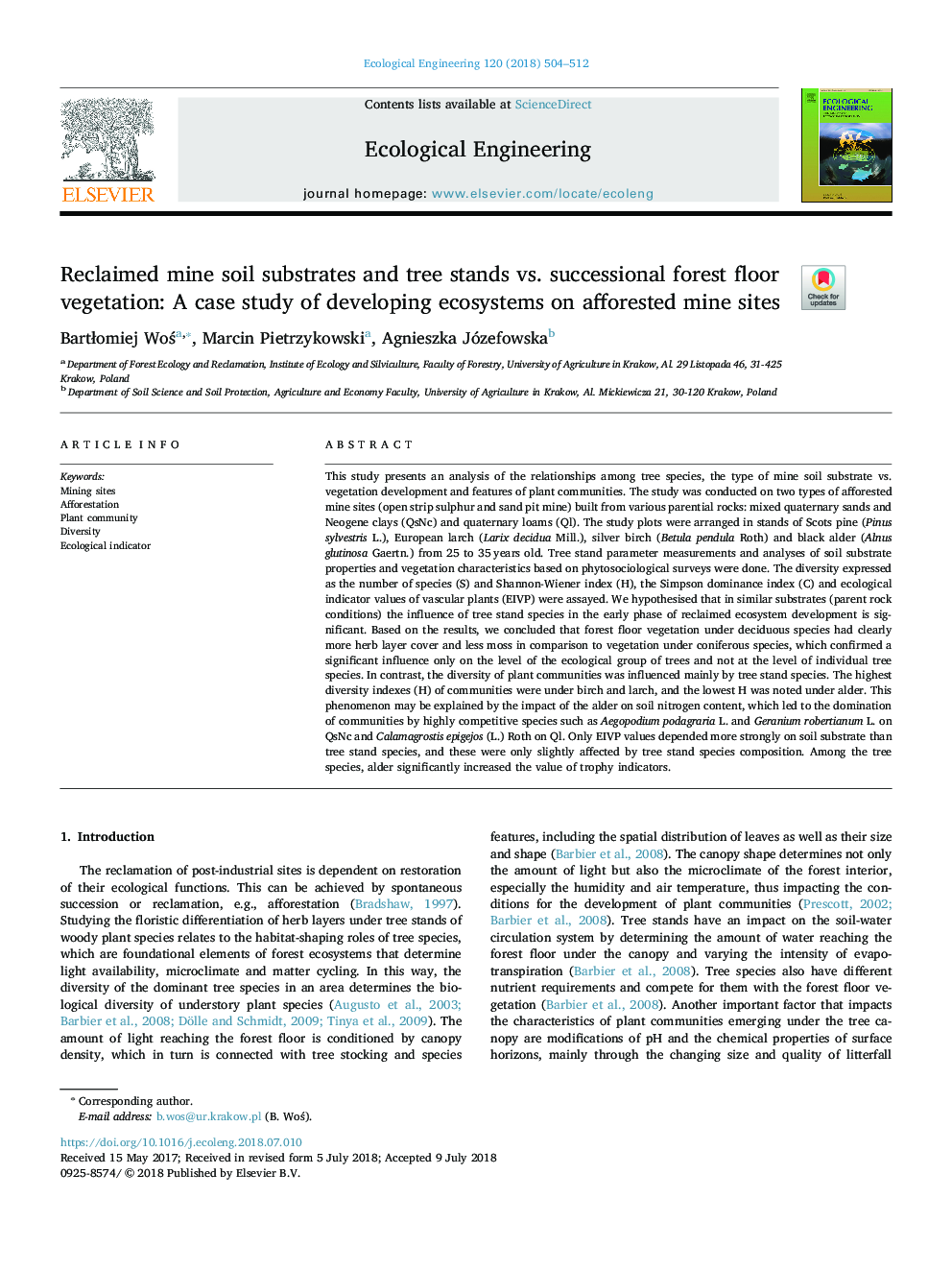| کد مقاله | کد نشریه | سال انتشار | مقاله انگلیسی | نسخه تمام متن |
|---|---|---|---|---|
| 8847859 | 1617982 | 2018 | 9 صفحه PDF | دانلود رایگان |
عنوان انگلیسی مقاله ISI
Reclaimed mine soil substrates and tree stands vs. successional forest floor vegetation: A case study of developing ecosystems on afforested mine sites
ترجمه فارسی عنوان
بسترهای زیرزمینی بازیافت شده و درختان در مقابل جنگل های جنگلی جانبداری: مطالعه موردی در حال توسعه اکوسیستم ها در مکان های معدنی جنگلی
دانلود مقاله + سفارش ترجمه
دانلود مقاله ISI انگلیسی
رایگان برای ایرانیان
کلمات کلیدی
سایت های معدن، جنگل زراعی، جامعه گیاهی، تنوع شاخص اکولوژیکی،
موضوعات مرتبط
علوم زیستی و بیوفناوری
علوم کشاورزی و بیولوژیک
بوم شناسی، تکامل، رفتار و سامانه شناسی
چکیده انگلیسی
This study presents an analysis of the relationships among tree species, the type of mine soil substrate vs. vegetation development and features of plant communities. The study was conducted on two types of afforested mine sites (open strip sulphur and sand pit mine) built from various parential rocks: mixed quaternary sands and Neogene clays (QsNc) and quaternary loams (Ql). The study plots were arranged in stands of Scots pine (Pinus sylvestris L.), European larch (Larix decidua Mill.), silver birch (Betula pendula Roth) and black alder (Alnus glutinosa Gaertn.) from 25 to 35â¯years old. Tree stand parameter measurements and analyses of soil substrate properties and vegetation characteristics based on phytosociological surveys were done. The diversity expressed as the number of species (S) and Shannon-Wiener index (H), the Simpson dominance index (C) and ecological indicator values of vascular plants (EIVP) were assayed. We hypothesised that in similar substrates (parent rock conditions) the influence of tree stand species in the early phase of reclaimed ecosystem development is significant. Based on the results, we concluded that forest floor vegetation under deciduous species had clearly more herb layer cover and less moss in comparison to vegetation under coniferous species, which confirmed a significant influence only on the level of the ecological group of trees and not at the level of individual tree species. In contrast, the diversity of plant communities was influenced mainly by tree stand species. The highest diversity indexes (H) of communities were under birch and larch, and the lowest H was noted under alder. This phenomenon may be explained by the impact of the alder on soil nitrogen content, which led to the domination of communities by highly competitive species such as Aegopodium podagraria L. and Geranium robertianum L. on QsNc and Calamagrostis epigejos (L.) Roth on Ql. Only EIVP values depended more strongly on soil substrate than tree stand species, and these were only slightly affected by tree stand species composition. Among the tree species, alder significantly increased the value of trophy indicators.
ناشر
Database: Elsevier - ScienceDirect (ساینس دایرکت)
Journal: Ecological Engineering - Volume 120, September 2018, Pages 504-512
Journal: Ecological Engineering - Volume 120, September 2018, Pages 504-512
نویسندگان
BartÅomiej WoÅ, Marcin Pietrzykowski, Agnieszka Józefowska,
